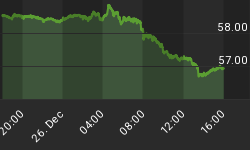From Michael Pento:
The Dow Jones 30 Industrial average has finally reached its all time record high (although unconfirmed by the S&P 500 and NASDAQ and well below a record if adjusted for inflation). The Dow and S&P are trading above the historical average PE ratios of 13 and 15, respectively. Does the outlook for earnings growth justify these levels? Clearly not. Q2 GDP was 2.6%, that's a deceleration of more than 40% from the first quarter. The equity markets are clearly pricing in a soft landing -- a rare phenomenon -- which puts the onus on the economy to produce that rosy scenario.
This optimistic view is bolstered by the softening in the oil market which is being touted as a panacea for the consumer and the housing market. Energy is a small part of both consumer's budget and the U.S. economy. The reverse wealth effects from declining home prices far outweighs the relief felt at the gas pump and as the real estate bubble unwinds, look for the consumer to continue to reign in his spending.
Currently the stock market is giving a nod to ebullient expectations for earnings. Investors are confident that the Fed Funds rate of 5.25% will gracefully decline to meet the ascending 4.6% yields of treasuries somewhere in the middle. If they are correct, perhaps I'll be proved wrong and this Dow record will be looked back upon as merely the beginning of a significant advance. If, however, the Fed Funds rate collapses in response to a recession or Treasury prices plummet due to intractable inflation, things could get ugly. If the optimistic scenario does not pan out, investors can capitalize on betting against the very crowded Goldilocks trade.
From Bruce Zaro:
Investors would be wise not to force money into the markets after the rally we've seen, waiting instead to deploy more capital on pullbacks, especially with the spooky market month of October having arrived. While September -- historically the market's worst month -- was surprisingly positive due largely to the Federal Reserve's pause, fears that the Fed already went to far are likely to intensify in October, leaving stocks at risk in the short-term. However, as more risk is wrung out of the market and today's overbought conditions ease, I will be looking to re-deploy funds in select sectors of the stock market and worry that if I'm wrong, it'll be in waiting for a pullback, that stocks will just keep rolling from here.
Note: mid-term elections have typically been followed by strong advances in stocks stocks, as was the case in 2002 and 1998. In fact, 10 out of the last 13 mid-term cycles marked significant market lows. Perhaps an October stock market correction would set the stage yet again, with even a modest pullback allowing for a vigorous rebound later in the year and into 2007. I believe this outcome is likely and that it will center around investors focusing on the next Fed move: lowering interest rates. That outcome, should it occur, will likely be farther away then many think, but investors may start to anticipate it later this year. Stocks will react very favorably to the Fed lowering rates and my outlook for 2007 is very optimistic under this scenario.
Sectors: energy, metals and mining stocks have fallen off the top of my list and have been replaced by healthcare providers, software and semiconductors. Longer-term technical conditions are really lining up for the latter, which suggest the odds favor these new sectors outperforming for some time to come. In the ETF and mutual fund universe, large cap value and non-U.S. assets continue to lead, for now.
From Chip Hanlon:
While Stephen Roach gets all the headlines at Morgan Stanly, it is another analyst there that I personally find to be at least as compelling: Richard Berner. His thesis, essentially: that the bond market is going overboard in pricing in a recession and the end of inflation. If economic growth rebounds, as he expects, inflation fears will return and interest rates will rise. I find this idea quite plausible.
If Berner's theory plays out, then today's stock market makes more sense; with the Dow making new highs it certainly isn't signaling recession in 2007. Perma-bears will tell you about the 1970's, when every Dow rebound to its previous highs turned out to be false and was followed by another nasty, multi-year plunge. Well, I certainly believe such history should be studied; if it is, then it's clear to see today's chart of the Dow looks nothing like it did then.
As the stock market initially rallied from its late-2002 lows, I was one of those who was skeptical, at one point early on even calling it the "mother of all sucker's rallies." Whoops. Looking now, however, at the way the Dow has spent the last 3 years nibbling away at the overhead resistance of its old highs (the same 3 years it spent building that top from 1999 to 2001 -- take a look at a long-term chart), it amounts to very impressive action, technically.
Are we overbought in the near term? Yes, but not wildly so. Certainly breakouts in most asset classes the last couple of years have tended to pull back, not carry through, so we might soon see something similar from stocks. That being said, the area between 10,000-11,000 should amount to massive support for the Dow, leading me to suspect that any corrections will continue to be short-lived and that the next major, long-term move in the Dow will be up, not down. Really, the Dow's long-term monthly chart it about as explosive as a chart can look.
Finally, sentiment has failed to become wildly bullish despite these fresh Dow highs; major market tops are not made when there remains so much mistrust of stocks.
*What about investment opportunities outside of the U.S? Read, "The Silk Road: an Investor's Guide to Asia's Largest Economies," our exclusive, free report by clicking here: http://www.deltaga.com/reportForm.asp?rep=3
















